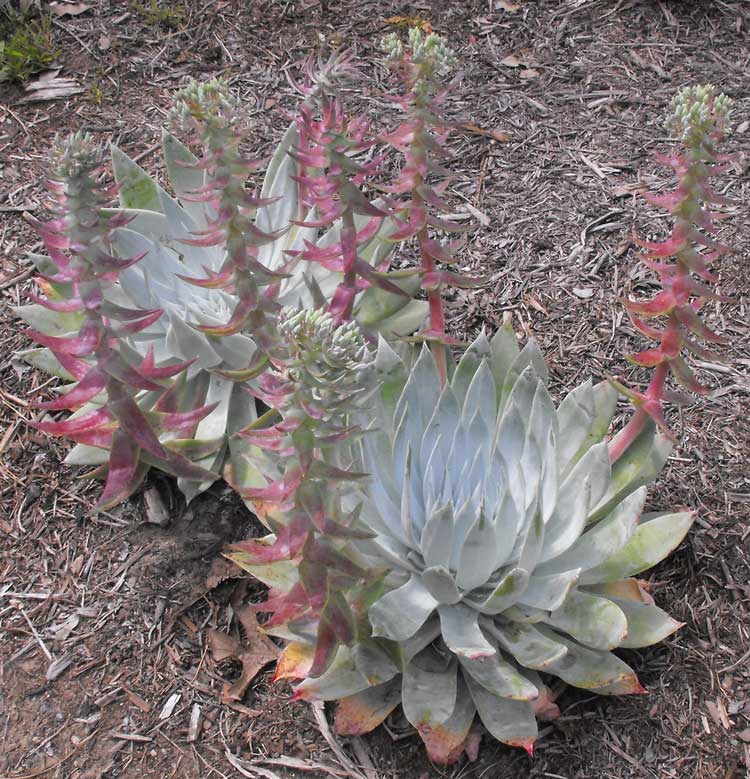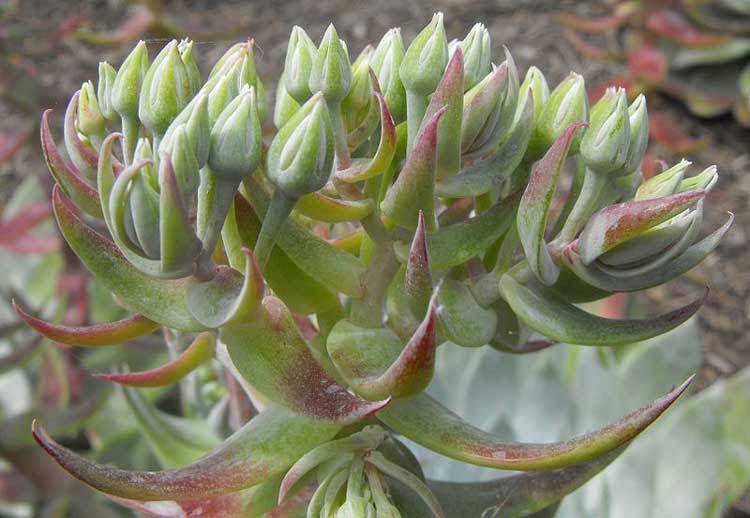
Dudleya brittonii
Classification System: APG IV
Superregnum: Eukaryota
Regnum: Plantae
Cladus: Angiosperms
Cladus: Eudicots
Cladus: Core eudicots
Ordo: Saxifragales
Familia: Crassulaceae
Subfamilia: Sempervivoideae
Tribus: Sedeae
Genus: Dudleya
Subgenus: D. subg. Dudleya
Species: Dudleya brittonii
Name
Dudleya brittonii D.A.Johans., Cact. Succ. J. (Los Angeles) 4: 311 1933.
Synonyms
Dudleya candida subsp. brittonii (Johansen) Moran
Dudleya viridis P. H. Thomson
Distribution
Native distribution areas:

Dudleya brittonii
References
Primary references
Johansen, D.A., 1943. Cactus and Succulent Journal. [Cactus and Succulent Society of America] 4:311.
Links
Hassler, M. 2019. Dudleya brittonii. World Plants: Synonymic Checklists of the Vascular Plants of the World In: Roskovh, Y., Abucay, L., Orrell, T., Nicolson, D., Bailly, N., Kirk, P., Bourgoin, T., DeWalt, R.E., Decock, W., De Wever, A., Nieukerken, E. van, Zarucchi, J. & Penev, L., eds. 2019. Species 2000 & ITIS Catalogue of Life. Published on the internet. Accessed: 2019 Dec 01. Reference page.
International Plant Names Index. 2019. Dudleya brittonii. Published online. Accessed: Dec 01 2019.
Govaerts, R. et al. 2019. Dudleya brittonii in Kew Science Plants of the World online. The Board of Trustees of the Royal Botanic Gardens, Kew. Published on the internet. Accessed: 2019 Dec 01. Reference page.
Tropicos.org 2019. Dudleya brittonii. Missouri Botanical Garden. Published on the internet. Accessed: 2019 Dec 01.
USDA, ARS, Germplasm Resources Information Network. Dudleya brittonii in the Germplasm Resources Information Network (GRIN), U.S. Department of Agriculture Agricultural Research Service. Accessed: 07-Oct-06.
Vernacular names
English: Britton's dudleya, giant chalk dudleya
Dudleya brittonii, with the common names Britton's dudleya, Britton's liveforever and giant chalk dudleya, is a succulent plant in the family Crassulaceae. It is native to the coast of northern Baja California, Mexico. Both forms of the plant have yellow leaves on a clustered rosette atop a large reddish-purple peduncle. The white form of the plant has a chalky epicuticular wax that reflects light and reacts with water. The green form of the plant is more common and found throughout a wider range. It is among the largest of the Dudleya.
Description
Dudleya brittonii has a short, stout caudex, often covered in dry leaves. Rosettes often grow solitarily out of the caudex. Basal leaves are numerous and erect. Younger leaves are linear-lanceolate, older leaves are oblong-lanceolate and much more wide and turgid at the base. Leaves are 7 to 11 cm long, and older leaves are 4.5 to 5.5 cm wide at the base. Leaves are flat above the middle but convex on both sides below, with a submedian keel on the upper surface, apiculate to acuminate, often with a red subulate tip. With age, leaves turn reddish-heliotrope.[1]
The flowering stem arises from the basal leaves, thin, erect, and reddish-purple. Bracts are horizontal, very thin, long-lanceolate, half encircle the stem, acuminate, light green or red, and prone to withering quickly after flowering.[1]
Cultivated specimen budding flowers. Note the yellow flowers, red peduncle, and large bracts that clearly distinguish this species from the smaller Chalk dudleya.
The inflorescence is cymose, about 10 cm across but narrow laterally, with vivid red branchlets holding erect, slender pedicels 7 to 9 cm long.[1]
The flower has a bright green calyx about 5 mm long, with acute, long-lanceolate segments. The corolla is erect, with a length of about 9 mm, cleft two-thirds to the base, composed of linear-lanceolate segments. The petals are hyaline to pale white, with the keel imbued in yellow.[1]
The leaves of the glaucous form of Dudleya brittonii are covered with a dusty, chalky, mealy white epicuticular wax. The wax in its mealy state on the leaves is attracted to water and coats drops on the leaves and prevents their evaporation. The wax has the highest measured ultraviolet reflectivity of any plant.[2]
Dudleya brittonii is similar in appearance to D. pulverulenta, which shares an overlapping distribution, and D. ingens, which only occurs further south.[1]
Taxonomy
Dudleya brittonii was discovered by a Mr. Howard E. Gates at the mouth of a canyon north of the 32nd parallel, supposedly "midway between Descanso and Ensenada." D. brittonii was described by Donald A. Johansen in 1933, in the fourth volume of the Cactus & Succulent Journal of America.[1]
It is named after Nathaniel Lord Britton, one of the botanists who first described the genus Dudleya.[1]
Green form
The "green form" of Dudleya brittonii
The green form of D. brittonii is regarded by some authors as a separate species, described as Dudleya viridis P.H. Thomson[3][4][5]
There are several differences in the morphology of D. brittonii and D. viridis[5]
The foliage of D. viridis has a distinctive apple-green, golden-green, to a bright dark green coloration. D. brittonii has a white coloration.
D. viridis has pendant flower heads, recurved bracts, and cream yellow, dark yellow or white flowers. D. brittonii has upright flower heads, horizontal bracts and pale yellow or white flowers.
D. viridis has as few as 40 leaves in young plants and as many as 190 leaves in old plants, the most in the Dudleya genus.
D. viridis will curve into a "ball" shape when it is dormant.
Furthermore, the flowering time between the green form and the glaucous form is very divergent, with the green form flowering up to six weeks or more later when cohabiting with the glaucous form. Researchers who have spent many years studying Dudleya brittonii, like Thomas W. Mulroy, agree with the conclusion that both forms deserve proper taxonomic recognition.[6]
Distribution and habitat
Dudleya brittonii occurs from extreme northwest Baja California from La Misión south to the vicinity of Eréndira and on the island of Todos Santos.[3] The glaucous, white form inhabits the bluff faces and steep slopes, whilst the green form inhabits rocky areas away from bluffs and the flat slopes of talus and soil below bluffs. Development along the Baja California coast is imperiling the species.[6]
Cultivation
Dudleya brittonii is cultivated as an ornamental plant for use in well-drained rock gardens and as a potted succulent.[7]
It has gained the Royal Horticultural Society's Award of Garden Merit.[8] In temperate climates it is normally grown under glass in cactus compost. However it can be placed outdoors in a sheltered, sunny spot during the summer months.[8]
See also
Dudleya candida
Dudleya pulverulenta
Dudleya ingens
References
Johansen, Donald A. Dudleya brittonii sp. nov. Cactus & Succulent Journal of America 4: 311, 1933
Spectral Properties of Heavily Glaucous and Non-Glaucous Leaves of a Succulent Rosette-Plant, Thomas W. Mulroy, Oecologia, 1979, [1]
Rebman, J. P., Gibson, J., & Rich, K. (2016). Annotated checklist of the vascular plants of Baja California, Mexico. San Diego Society of Natural History.
Dudleya viridis P.H.Thomson in GBIF Secretariat (2021). GBIF Backbone Taxonomy. Checklist dataset https://doi.org/10.15468/39omei accessed via GBIF.org on 2021-08-19.
Thompson, P. (1993). "Dudleya viridis". Dudleya and Hasseanthus Handbook. Bonsall Publications: 202–204.
Mulroy, Thomas W. (16 January 2015). "Investigating reproductive character displacement in Dudleya brittonii (Crassulaceae) in northwestern Baja California, Mexico, over the last 40 years: An intact landscape is essential to our ability to understand important biological problems". YouTube. Leidos, Inc. and the Santa Barbara Botanic Garden. Archived from the original on 16 September 2021.
San Marcos Growers
"Dudleya brittonii". www.rhs.org. Royal Horticultural Society. Retrieved 3 June 2020.
Retrieved from "http://en.wikipedia.org/"
All text is available under the terms of the GNU Free Documentation License

